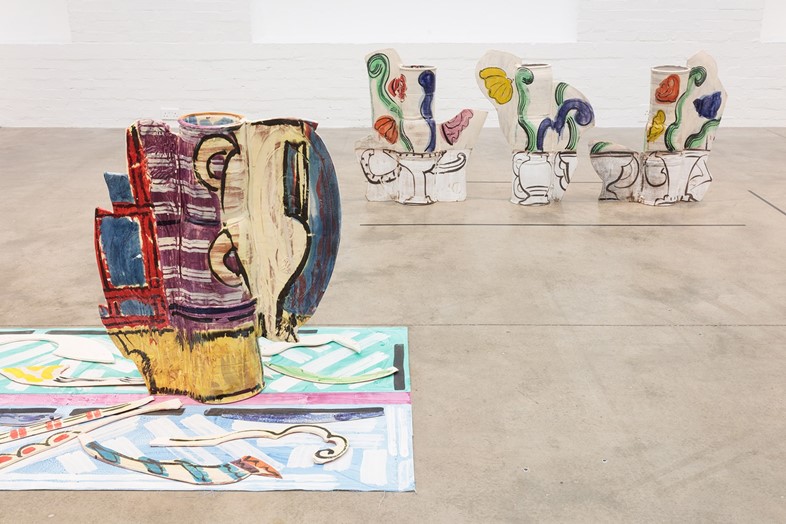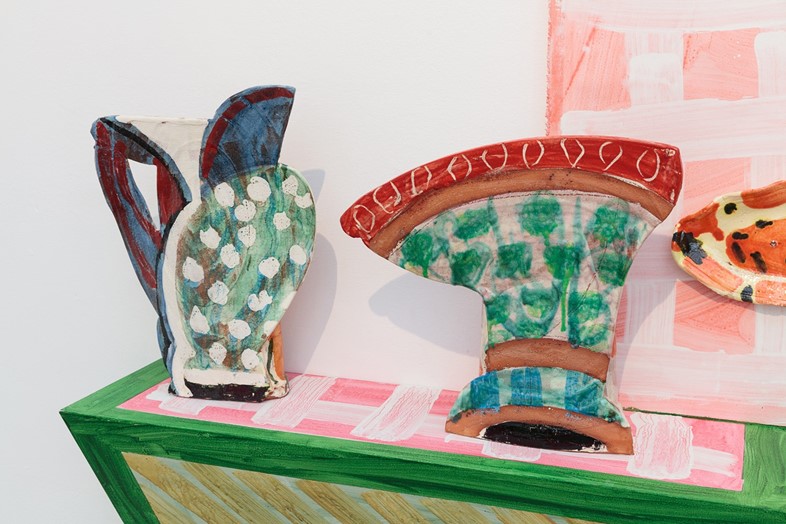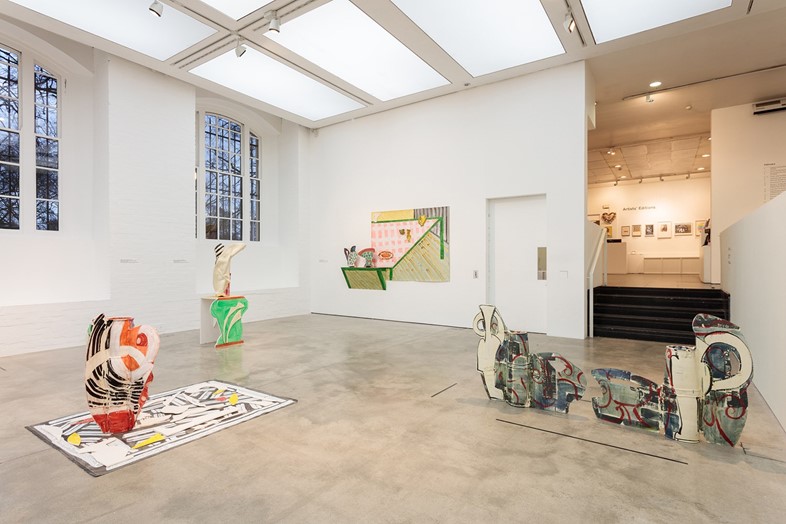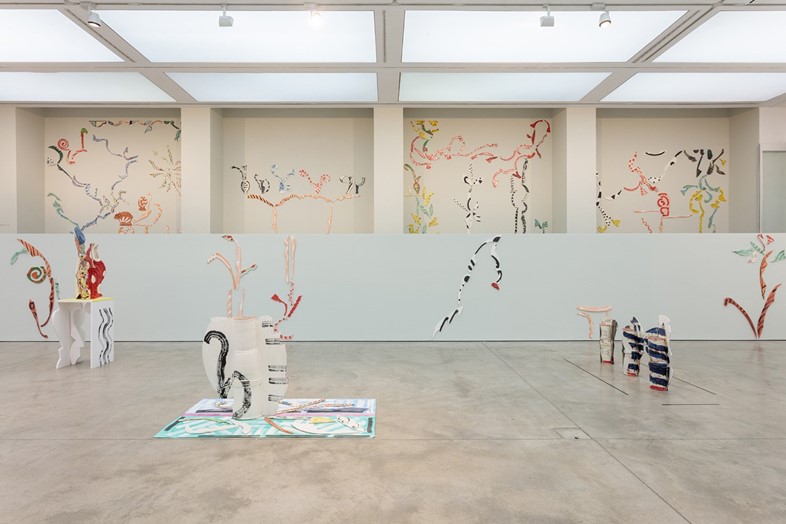As her first major solo exhibition opens at London's ICA, the feted artist tells AnOther about the renaissance of clay, chance compositions and making it at 85
To say that Betty Woodman is a prolific artist is an understatement. At 85, only somewhat diminished in physical strength since she first used a kiln as a teenager, she remains completely committed to her work, a ravishing array of paintings and sculptures in exuberant colours that more often than not incorporate clay. "I think that making art is simply for me where the passion lies, looking at it, thinking about it, making it," she says, on the eve of her first major solo exhibition in London, at the ICA. "I like to do other things, but that's the most important thing."
In the last ten years, after decades as a working potter and artist, she is finally getting the attention her work so deserves. But Woodman has always followed her own path. She and her husband, fellow artist George Woodman, first met in a pottery class she was teaching in Boston in 1950, marrying not long after against the wishes of his family and settling in Colorado. As her husband worked on his paintings, Betty became a production potter, making beautiful, artfully strange versions of traditional domestic vessels, from a row of joined-up vases to a pouring jug shaped like a pillow and painted in abstract expressionist style. Later in life, she abandoned her production work to focus on her art, moving with George to New York in their 50s to take on the city's famously chilly art world, a gamble which paid off handsomely — in 2006, she commanded a solo show at the Metropolitan Museum and now shows at Jeanne Greenberg Rohatyn's Salon 94.

Betty and George have enjoyed a long creative partnership, filled with colour and travel, yet also indelibly touched by tragedy. (Their daughter, the artist Francesca Woodman, took her own life at the age of 22, leaving behind a cache of exquisite black and white photographs that redefined the self-portrait and command museum exhibitions the world over). Dividing their time between New York and Tuscany, where they have a beautiful home they bought "for next to nothing" in the 60s, the Woodmans maintain a rigorous work ethic, which, as Betty explains, is born of an intense love for what they do. At the ICA, she is showing a compendium of work made over the last ten years, including a new site-specific "wallpaper" spanning an entire length of wall, an arresting configuration of brightly coloured spare shards of pottery. Titled Theatre of the Domestic, the works, some of them domestic tableaux, some freestanding sculptures, have an almost performative quality (the late, great critic Arthur C Danto went as far as to describe her objects as anthropomorphic), filling the austere white rooms with their colourful chatter.
Long sidelined from artistic discourse, ceramics have enjoyed a quiet spotlight over the last couple of years, a fact which bemuses the woman who has long extolled the virtues of clay as a material. Here, she tells AnOther about how she approaches her work, deconstructing the colours from her favourite paintings and the magic that happens in a kiln.

On her attraction to clay as a material...
"It's such a funny question everybody asks. Let's say it was 80 years ago, when I was six years old, I used clay. I think I just liked the clay! Out of nothing, you make something – it's magic. With your hands, you do something. You don't need a tool – though I do use a wheel. Take this material with your hands and make something, make beautiful stuff. But as I used to say to my students, you can always feed the cat, if nothing else, [clay will] hold water. It is kind of domestic in that sense."
On the role of chance in her work...
"My work really doesn't come about by making decisions, it really comes about as I'm doing it. I think it often comes about through observations within the studio, within my life that sort of feed into it. Anybody who works with ceramics, chance is a part of it. It's a change that happens, the magic that happens in the kiln. One always hopes it's going to come out better than it went in."

On the physical nature of working with clay...
"It's a lot of hard work. Sometimes I think, nobody knows how hard I work! I think it's probably very good for me. They say exercise, walking… it's good for one to keep moving."
On her use of colour...
"I think it's not so much where I am [in the world] but other works of art determine the colours. Maybe those Bonnard paintings, maybe Gauguin paintings… I remember, with Gauguin's palette, writing a list and using all those colours. Just listing all the colours that seemed to make sense. I think I get colours from works of art all the time. There's a painting upstairs that's from a small Fra Angelico painting, I took all the colours in it and used them in that painting. It doesn't look like Fra Angelico but it has all the colours."

On having her first big solo show in Italy this past summer...
"It was exciting. We've had a house and studio there for 50 years so it's not something new in our lives. It was in the basement, the crypt of a church which houses Marino Marini's sculptures. The newspaper had a headline calling me "L'Americana di Antella", which is where we have our home. I finally made it! It pleased me greatly."
On the current interest in ceramics...
"I think what's happened, suddenly, clay is a legitimate material. For some reason, I slipped into this but it certainly wasn't that the rest of the art world was ready to consider what I made as art. In the last 30 years, lots has changed. Recently, nobody's saying you can't make art out of clay. Ten years ago, lots of people said you don't make art out of clay. But it happened with photography. Today, who knows. It's a material there was a lot of hostility towards and I certainly appreciate the fact that that's broken down. I think it'll be a long time before we see what's interesting in terms of what's being done."

Betty Woodman: Theatre of the Domestic runs until April 10, 2016 at the Institute of Contemporary Arts, London.
